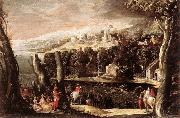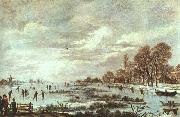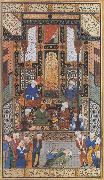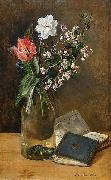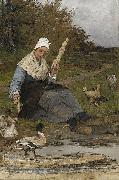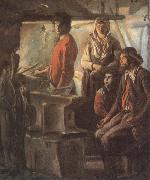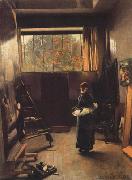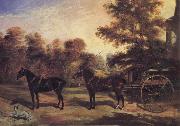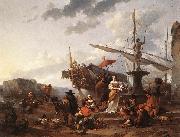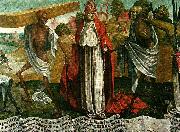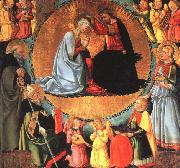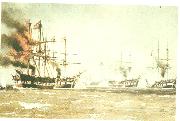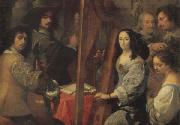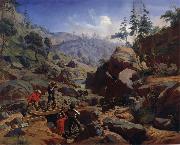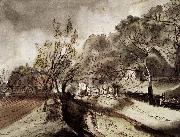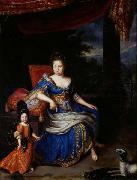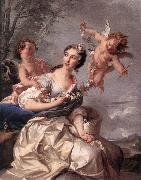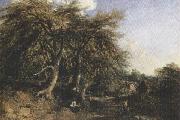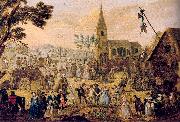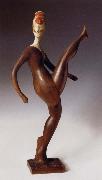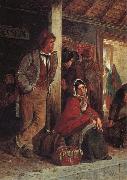|
|
|
|
|
|
 |
ABILDGAARD Nicolai
|
|
Nikolaj Abraham Abildgaard (September 11, 1743 - June 4, 1809), Danish artist, was born in Copenhagen, the son of Søren Abildgaard, an antiquarian draughtsman of repute, and Anne Margrethe Bastholm.
|
|
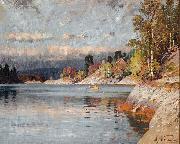 |
Adelsteen Normann
|
|
Adelsteen Normann (1 May 1848 - 26 December 1918) was a Norwegian painter who worked in Berlin. He was a noted painter of landscapes of Norway. Normann was the artist who invited Edvard Munch to Berlin, where he painted The Scream. Normann's fjord paintings are credited with making the Norwegian fjords a more popular tourist destination. |
|
|
|
|
|
|
|
|
|
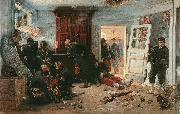 |
Alphonse-Marie-Adolphe de Neuville
|
|
(31 May 1835 - 18 May 1885) was a French Academic painter who studied under Eugene Delacroix. His dramatic and intensely patriotic subjects illustrated episodes from the Franco-Prussian War, the Crimean War, the Zulu War and portraits of soldiers. Some of his works have been collected by the Hermitage Museum in St. Petersburg and by the Metropolitan Museum in New York.
The Last Cartridges, 1873
The Defence of Rorke's Drift, oil on canvas painting by Alphonse-Marie-Adolphe de Neuville, 1880, Art Gallery of New South Wales. This incident occurred on 22 January 1879, in the Anglo-Zulu War.
La bataille de VillersexelHe was born to wealthy parents at Saint-Omer, Pas-de-Calais. From school he went to college, where he took his degree of bachelier -lettres. In spite of the opposition of his family he entered the naval school at Lorient, and it was there, in 1856, that his artistic instincts first declared themselves.
After being discouraged by several painters of repute, he was admitted to work in François-Edouard Picot's studio. He did not remain there long, and he was painting by himself when he produced his first picture, The Fifth Battalion of Chasseurs at the Gervais Battery (Malakoff). In 1860 Neuville painted an Episode of the taking of Naples by Garibaldi for the Artists' Club in the rue de Provence, and sent to the Paris Salon in 1861 The Guard Chasseurs in the Trenches of the Mamelon Vert.
He participated in illustrating the Hetzel editions of Twenty Thousand Leagues Under the Sea. He also illustrated Le Tour du monde and Guizot's History of France. At the same time he painted a number of remarkable pictures: The Attack in the Streets of Magenta by Zouaves and the Light Horse (1864), A Zouave Sentinel (1865), The Battle of San Lorenzo (1867), and Dismounted Cavalry crossing the Tchernaia (1869). In these he showed peculiar insight into military life, but his full power was not reached until after the Franco-Prussian War. He then aimed at depicting in his works the episodes of that war, and began by representing the Bivouac before Le Bourget (1872). His fame spread rapidly, and was increased by The Last Cartridges (1873), memorializing an episode involving the Blue Division of the French marines, in which it is easy to discern the vast difference between the conventional treatment of military subjects, as practised by Horace Vernet, and that of a man who had lived the life that he painted.
In 1874 the Fight on a Railroad was not less successful, and was followed by the Attack on a House at Villersexel (1875) and the Railway Bridge at Styring (1877). In 1878 the painter exhibited (not at the Great Exhibition) Le Bourget, the Surprise at Daybreak, The Intercepted Despatch-bearer, and a considerable number of drawings. He also exhibited in London some episodes of the Zulu War. Fifty thousand people paid to see his impression of The Defence of Rorke's Drift (1880), which the infant Art Gallery of New South Wales in Sydney paid a large sum to acquire.
In 1881 he was made an officer of the Legion d'honneur for The Cemetery of Saint-Privat and The Despatch-bearer and the "Huns in the Battle of Chalon." During these years Neuville was at work with Édouard Detaille on an important though less artistic work, The Panorama of Rezonville. Neuville died in Paris on May 18, 1885. At the sale of his works the state purchased for the Palais du Luxembourg the Bourget and the Attack on a Barricaded House, with a water-color The Parley, and a drawing of a Turco in Fighting Trim.
|
|
 |
Amaldus Clarin Nielsen
|
|
(23 May 1838 - 10 December 1932) was a Norwegian painter.
He was born in Halse as a son of shipmaster and merchant Niels Clemetsen Nielsen (1795 - 1845) and his wife Andrea Marie Møller (1802 - 1866). He grew up in Mandal in Vest-Agder county, Norway. He lived most of his childhood and adolescence without a father. He received some tuition from a traveling drawing teacher and traveled to Copenhagen to study in 1854
|
|
|
|
|
|
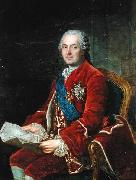 |
Anne Baptiste Nivelon
|
|
Portrait de Louis de France, dauphin (1729 - 1765) represente tenant des plans militaires |
|
|
|
|
|
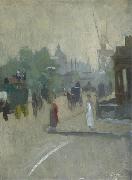 |
August Neven du Mont
|
|
August Ludwig Mathaeus Neven du Mont (1866-1909) was a German Painter, Master of Foxhounds for East Sussex and aristocrat. Very famous and popular during his lifetime he went from very successful to almost unknown after his early death in 1909. Historian Paul Clemen wrote two books about the life and work of the artist as well as one booklet which was never published. Most of Neven du Mont's Paintings were portraits for which he was most known. In July 1909, he died in his Manor House in Bexhill of which he was the last tenant before its destruction. He was also an ancestor of the well known German actor Sky du Mont.
|
|
|
|
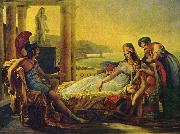 |
Baron Pierre-Narcisse Guerin
|
|
(13 May 1774 - 6 July 1833) was a French painter.
Guerin was born in Paris.
A pupil of Jean-Baptiste Regnault, he carried off one of the three grands prix offered in 1796, in consequence of the competition not having taken place since 1793. In 1799, his painting Marcus Sextus (Louvre) was exhibited at the Salon and excited wild enthusiasm. Part of this was due to the subject - a victim of Sulla's proscription returning to Rome to find his wife dead and his house in mourning - in which an allusion was found to the turmoil of the French Revolution.
Guerin on this occasion was publicly crowned by the president of the Institute, and went to Rome to study under Joseph-Benoît Suvee. In 1800, unable to remain in Rome on account of his health, he went to Naples, where he painted the Grave of Amyntas. In 1802 Guerin produced Phaedra and Hippolytus (Louvre); in 1810, after his return to Paris, he again achieved a great success with Andromache and Pyrrhus (Louvre); and in the same year also exhibited Cephalus and Aurora (Louvre) and Bonaparte and the Rebels of Cairo (Versailles). These paintings suited the popular taste of the First Empire, being highly melodramatic and pompously dignified.
The Restoration brought to Guerin fresh honours; he had received from the first consul in 1803 the cross of the Legion of Honour, and in 1815 Louis XVIII named to the Academie des Beaux-Arts. His style changed to accord with popular taste. In Aeneas Relating to Dido the Disasters of Troy (Louvre), Guerin adopted a more sensuous, picturesque style.
Guerin was commissioned to paint for the Madeleine a scene from the history of St Louis, but his health prevented him from accomplishing what he had begun, and in 1822 he accepted the post of director of the French Academy in Rome, which in 1816 he had refused. On returning to Paris in 1828, Guerin, who had previously been made chevalier of the order of St. Michel, was ennobled. He now attempted to complete Pyrrhus and Priam, a work which he had begun at Rome, but in vain; his health had finally broken down, and in the hope of improvement he returned to Italy with Horace Vernet. Shortly after his arrival at Rome Baron Guerin died, on the 6th of July 1833, and was buried in the church of La Trinite de Monti by the side of Claude Lorrain.
|
|
 |
Bartolomeo Nazari
|
|
Bartolomeo Nazari (May 31, 1693 - August 24, 1758) was an Italian painter of the late-Baroque, mainly active in Venice as a portraitist.
Born in Clusone, near Bergamo. By 1716, he had become an apprentice under Angelo Trevisani, but visited in 1723 the Roman studio of Angelo's brother, the Venetian Francesco Trevisani, and then also studied with Benedetto Luti. Nazari likely knew personally Fra Galgario, the renowned portraitist from Bergamo, and is described by some as a pupil. He returns to Venice in 1724, and is registered with the Fraglia dei Pittori by 1726. In 1744, he traveled to Frankfurt to paint the emperor Charles VII and his family and other members of the court. In 1756, he was inducted into the newly founded Accademia of Venice. His son Nazario Nazari was also a painter. Among his patrons was Consul Joseph Smith and the former general Johann Matthias von der Schulenburg (who owned over eight diverse portrait paintings). He painted the portraits of a number of operatic singers including Farinelli. He died returning from Genoa, where he had painted the Doge. |
|
|
|
|
|
|
|
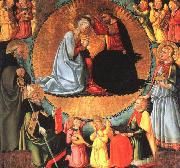 |
Bicci Di Neri
|
|
(1419-1491) was an Italian painter of the Renaissance. A prolific painter of mainly religious themes, he was active mainly in Florence and in the medium of tempera. His father was Bicci di Lorenzo. His grandfather, Lorenzo di Bicci was also a painter in Florence, a pupil of Spinello Aretino.
Neri di Bicci's main works include a St. John Gualbert Enthroned, with Ten Saints for the church of Santa Trinita, an Annunciation (1464) in the Florentine Academy, two altarpieces in the Diocesan Museum of San Miniato, a Madonna with Child Enthroned in the Pinacoteca Nazionale of Siena, and a Coronation of the Virgin (1472) in the abbey church at San Pietro a Ruoti (Bucine. He also painter numerous works in the area of Volterra.
His journals from the years 1453-1475, including the rates of remuneration for his work, are still preserved in the library of the Uffizi Gallery. They are known as Ricordanze.
|
|
|
|
|
|
 |
carl kylberg
|
|
Carl Oscar Kylberg, född 23 september 1878 på Vasängen i Fridene församling, död 6 januari 1952 i Stockholm, svensk konstnär och representant för Göteborgskoloristerna.
Carl Kylberg var son till kontorschef Gustaf Kylberg och friherrinnan Eleonora von Essen och storebror till konstnären Erik Kylberg. Hans fastrar och farbror var konstnärerna Regina Kylberg-Bobeck, Marina Kylberg och Hjalmar Kylberg. Farfadern Lars Wilhelm Kylberg var konstnär vid sidan av lantbruket på familjegodset Såtenäs i Västergötland.
Kylberg studerade först vid tekniska skolan i Stockholm och i Berlin för att bli arkitekt men övergick till måleri omkring 1900. Han studerade under en tid vid Valand i Göteborg som elev till Carl Wilhelmson. Hans verk kännetecknas ofta av ett glödande oljemåleri med starka färger och han avbildade ofta landskap och figurkompositioner på ett avskalat man??r. Under senare delen av sitt konstnärskap skapade han en mängd religiösa motiv.
Kring 1930-talet fick han sitt genombrott och han kom att ställa ut, förutom i Sverige även i Köpenhamn, Paris, London, Budapest och i USA men hans måleri var för många provocerande och 1938 gick regeringen in och stoppade ett köp av målningen Uppbrottet för Nationalmuseum i Stockholm.
En av hans mest välkända målningar är Hemkomsten från 1938 som hänger på Göteborgs konstmuseum och som föreställer ett skepp i silhuett mot en nästan brinnande gul himmel och ett rödfärgat hav. Denna målning förevigades också 1978 på ett svenskt frimärke av valören 90 öre.
Sedan 1980-talet har många av hans tavlor sålts för rekordpriser vid olika internationella konstauktioner.
|
|
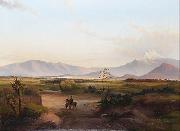 |
Carl Nebel
|
|
Carl/Carlos Nebel (March 18, 1805 - June 4, 1855) was a German engineer, architect and draughtsman, best known for his detailed paintings of the Mexican landscape and people and of the battles of the Mexican-American War.
Nebel was born at Altona, today a part of Hamburg. After studies in Hamburg and Paris, he travelled to America, where he was a resident of Mexico from 1829 until 1834. In 1836, he published in Paris his renowned illustrated work on that country-Voyage pittoresque et archeologique dans la partie la plus interessante du Mexique, with 50 lithographs made from his paintings, twenty of which were hand-colorized, and an introduction written by Alexander Humboldt. |
|
|
|
|
|
|
|
|
|
|
|
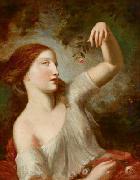 |
Charles-Joseph Natoire
|
|
(3 March 1700 - 23 August 1777) was a French painter in the Rococo manner, a pupil of François Lemoyne and director of the French Academy in Rome, 1751-1775. Considered during his lifetime the equal of François Boucher, he played a prominent role in the artistic life of France.
He is remembered above all for the series of the History of Psyche for Germain Boffrand's oval salon de la Princesse in the Hôtel de Soubise, Paris, and for the tapestry cartoons for the series of the History of Don Quixote, woven at the Beauvais tapestry manufacture, most of which are at the Château de Compiegne.
|
|
|
|
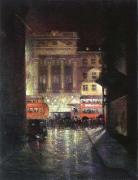 |
christopher r.w.nevinson
|
|
christopher r.w.nevinson(1889 to 1946)English painter. Son of H. W. Nevinson, the war correspondent and author, he studied painting at St John's Wood, London, in 1908, although his formative years as a student were spent at the Slade School of Art (1909-12) in London. He was influenced by Impressionism and Post-Impressionism, as well as Sandro Botticelli, as seen from an early Self-portrait (1911; London, Tate). The Futurist Exhibition of March 1912, held at the Sackville Gallery, London, proved decisive for his development. He met Gino Severini and returned with him to Paris where he encountered Umberto Boccioni, Ardengo Soffici, Guillaume Apollinaire and Amedeo Modigliani. He continued his studies at the Acad?mie Julian and the Cercle Russe in Paris, announcing his affiliation with Futurism by exhibiting a painting called Rising City (1912; lost) in the Friday Club exhibition of January 1913. Its title was a homage to Boccioni's painting, City Rises (1910; New York, MOMA), which had been shown at the Futurist Exhibition.
|
|
|
|
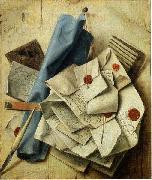 |
Cornelis Norbertus Gysbrechts
|
|
(ca 1630 - after 1683) was a Flemish painter of still life and trompe-l'œil active in the second half of the seventeenth century.
Gysbrechts was born in Antwerp, where, according to the RKD, he became a member of the Guild of St. Luke in 1660. He signed his name with "CND". His first known paintings date from 1659 in Antwerp. He painted in 1664 in Regensburg, from 1665-1668 in Hamburg and from 1668 to 1672 at the court in Copenhagen. |
|
|
|
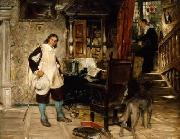 |
David Dalhoff Neal
|
|
(October 20, 1838 - May 2, 1915), was an American artist.
David Dalhoff Neal was born to father Stephen Bryant Neal and mother Mary (Dalhoff) Neal, on Middlesex Street, in Lowell, Massachusetts. His grandparents were Stephen Neal, and David Dalhoff and Sally (Bean) Dalhoff of Canterbury, New Hampshire, Dolhoffs that emigrated from Russia in 1763, for whom he was named. His mother's family, the Beans, migrated from Holland in the early 1830s. His aunt Elizabeth Dolhoff was very artistic, and his uncle Jesse Dolhoff was a great singer.
He attended Lowell grammar schools, and high school at Lawrence, Massachusetts. Deciding to devote himself to the study of art, he then attended art classes at the recently opened Andover Academy in Andover, New Hampshire. When Neal was 14, his father died and his fortunes were "impaired", so he set sail for New Orleans. Here at the age of 15, he worked the docks as a wharf clerk with a wood shipping firm dealing in Brazilian and Honduran mahogany. |
|
|
|
|
|
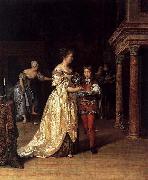 |
Eglon van der Neer
|
|
(1635/36, - May 3, 1703), was a Dutch painter of historical scenes, portraits and elegant, fashionable people, and later of landscapes.
Van der Neer was born in Amsterdam and was probably first taught by his father, Aert van der Neer, who married in Amsterdam in 1629, coming from Gorinchem. Eglon had a least five brothers and sisters, who were baptized in the Nieuwe Kerk between 1640 and 1650. He took lessons from Jacob van Loo, who was then one of the foremost figure painters in Amsterdam. Around 1654 Van der Neer, who probably had just finished his education with Van Loo, traveled to Orange, Vaucluse in the South of France and entered the service of Friedrich von Dohna (1621-1688), Governor of the Principality of Orange. Van der Neer stayed for three or four years in Orange and returned to Amsterdam by the end of 1658. There he married in February Maria Wagensvelt, the daughter of a wealthy Rotterdam notary. In 1663 Van der Neer and his family moved to Rotterdam, where Adriaen van der Werff became his student. He stayed in Rotterdam until his wife died in 1677. In 1679 he moved to The Hague and in 1680 he became a member of the Confrerie Pictura there. Later that year he moved again, taking up his residence at Brussels, where he married the miniature painter Marie Du Chastel in the following year. She bore him nine children.
|
|
|
|
|
|
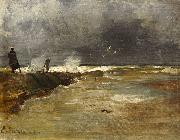 |
Emil Neumann
|
|
painted Strandspaziergang bei Wellengang in 1890 |
|
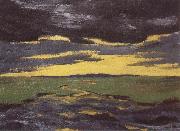 |
Emil Nolde
|
|
German Expressionist Painter, 1867-1956 |
|
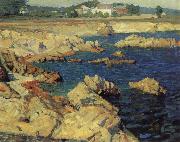 |
Ernest Bruce Nelson
|
|
American,a native of Northern California and a graduate of Stanford University
1888-1952
|
|
|
|
 |
Etienne Moreau-Nelaton
|
|
Adolphe Etienne Auguste Moreau-Nelaton (2 December 1859, Paris- 25 April 1927, Paris) was a French painter, art collector and art historian. His large collection is today held in its entirety by National French museums.
Moreau-Nelaton's family's art collecting began with his grandfather Adolphe Moreau (1800-59). As a stockbroker he possessed ample capital with which to buy the work of artists with whom he was personally acquainted, including Eugene Delacroix and Alexandre-Gabriel Decamps. Moreau-Nelaton's father, who was also named Adolphe Moureau (1827-82), was a high government official and led the railroad company Chemins de fer de l'Est. In 1856 he married the ceramic artist Camille Nelaton (1840-97), with whom he further expanded the family's collection. |
|
|
|
|








